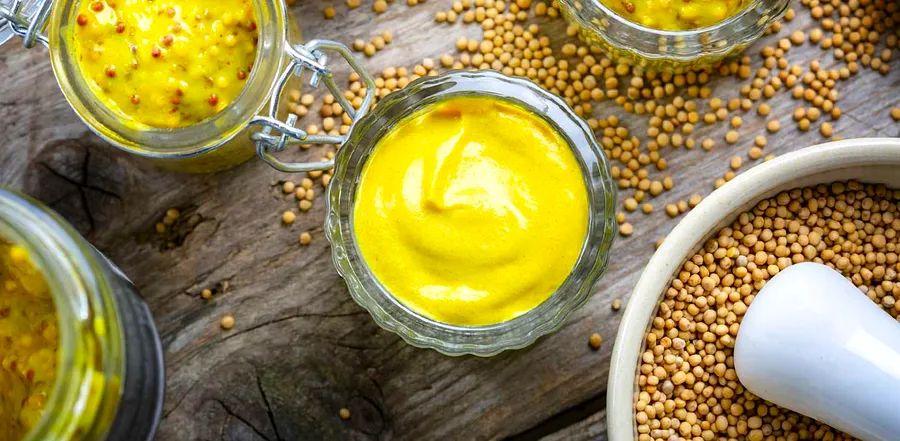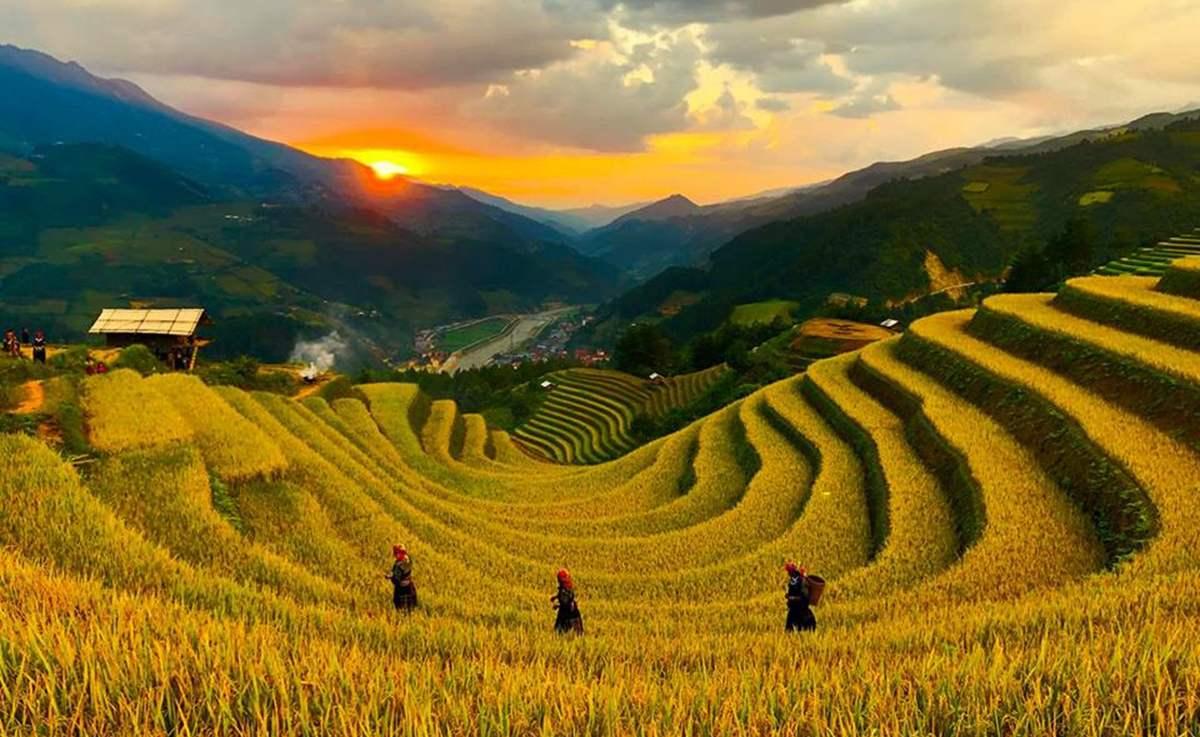Everything You Ever Wanted to Learn About Mustard

Cheeseburgers. Hot dogs. Sandwiches. Salad dressings. Classic yellow stadium snacks.
Mustard is everywhere we turn. For many, just thinking about it brings back fond memories. Its versatility is unmatched, and its history spans centuries in the culinary world. But what exactly is this flavorful spread, and where did it originate?
What Is Mustard, and What Goes Into It?
The mustard plant belongs to the Brassica family and produces mustard seeds—black, brown, and white varieties tend to pack more punch than the mild yellow kind we’re most familiar with in bottles.
Mustard, or moutarde in French, is most commonly recognized as a condiment sold in jars or bottles. This smooth spread is made from ground or whole mustard seeds, combined with water, vinegar, or other liquids, and blended into a creamy consistency.

Find the recipe: Honey Mustard Roasted Chicken
Most commercially available mustard is made with yellow (white) or brown seeds, or a blend of the two. Black mustard seeds are rarely used in these mixes, instead being sold whole, particularly in Indian and international markets, where they are a staple in Indian cuisine.
Mustard seeds are also available in the spice aisle or mixed in with other dry goods, often labeled as dried mustard, ground mustard, or mustard flour.
The Origins of Mustard
What we know for certain is that mustard has been around since biblical times. It’s one of the oldest spices on record, mentioned in ancient Sanskrit texts as far back as 3000 BC. Beyond that, the history is steeped in legend.
One popular tale involves the Duke of Burgundy, who awarded the city of Dijon a coat of arms bearing the motto Moult Me Tarde, meaning "I ardently desire." This was in thanks for the city's military success in 1382. However, when the motto was carved into the gates, the middle word was mistakenly omitted, leaving only "moult tarde", or "burn much." This amusing error caught the attention of travelers and traders, who started referring to the local mustard by this name.
What Does Mustard Taste Like?
Mustard seeds themselves are quite powerful, often described as fiery, with the brown variety being more intense than the milder white one. When prepared, the additional ingredients—like wine, beer, particular spices, or herbs—and how finely the seeds are ground all influence the flavor, giving each jar its unique character.
No matter the variation, there’s always some level of spiciness due to the seeds’ natural heat, whether it’s a subtle, slow burn or an intense, sharp heat. Beyond that, mustard carries a touch of sweetness, a hint of bitterness, and a delicate floral fragrance.
Varieties of Mustard
When we think of mustard, we often picture the iconic bright yellow squeeze bottle or recall memories of a ballpark snack. But mustard can also appear as a grainy, seeded spread on a charcuterie board or as an exciting discovery like a jar of dill mustard. These are all types of prepared mustard, which is the form we use most, but mustard is also available as seeds, powder, and oil.

Find the recipe: Beer Mustard
Mustard seeds are often used in pickling spice blends and can be toasted and cracked for use in cooking. Ground mustard, also known as powdered mustard, is commonly added to sauces, vinaigrettes, or spice rubs, or used to create homemade mustard. Mustard oil, much like olive oil, can be drizzled over finished dishes to add a burst of flavor.
There are seven main types of prepared mustard: yellow, Dijon, brown (also known as deli or ballpark), German, Chinese, English, and whole grain (or coarse grain).
Yellow
This is the classic, the bright yellow bottle we all know from childhood. Made from finely ground white mustard seeds, the striking yellow color actually comes from turmeric. Its flavor is tangy rather than spicy, making it a favorite topping for hot dogs and sandwiches, though it’s not commonly used in cooking.
Dijon
Dijon mustard is crafted from brown (and sometimes black) seeds, giving it a brown hue, but it’s not considered "brown mustard." The key distinctions are that it must be produced in the French city of Dijon (with strict government regulations), and if made elsewhere, it must be labeled as "Dijon-style." The addition of white wine helps to mellow its acidity, allowing the mustard's natural heat and sharpness to take center stage.
Deli (American Brown or Ballpark)
This variety of brown mustard is made from brown seeds, offering a mild heat and less tartness than yellow mustard. It may have a coarser texture and speckled appearance if the seed hulls are left intact. Depending on the brand, additional spices like nutmeg or allspice may be added to create a distinctive flavor profile.
German
Mustard and Germany go hand in hand. It’s almost impossible to fully enjoy a bratwurst or pretzel without a generous helping of mustard. German mustard comes in a variety of textures, flavors, and heat levels, but the two primary types are both made from brown seeds: a hot, smooth variety and a Bavarian-style mustard that’s coarser, milder, and sweeter (much like their famous sauerkraut).
Chinese
Chinese mustard is by far the most intense. Its distinctiveness lies in its simplicity—just ground spicy brown seeds mixed with cold water to create a loose condiment. The cold water preserves the mustard’s fiery compounds, unlike hot water or vinegar. It’s a sharp, sinus-clearing punch that hits hard upfront and fades quickly. Those little brownish-yellow packets you get with your takeout? This is the mustard inside.
English
The most iconic English mustard brand is Colman’s, known for its bright yellow tin or label with a bold red logo. The seeds are mixed with cold water, similar to Chinese mustard, to retain their intensity, but the addition of white mustard seeds gives it a milder flavor, making it a less fiery but still flavorful option.
Whole or Coarse Grain
As the name implies, whole grain mustard keeps the seeds intact, resulting in a grainy texture that contrasts with the smoother varieties. Typically made from brown seeds, it combines whole and ground mustard forms. Pickled whole seeds, sometimes referred to as mustard caviar, are soaked in just enough liquid to let them swell and form a spreadable consistency.
How to Cook With Mustard
In the kitchen, mustard is the ultimate multi-tasker. It’s not just a condiment for hot dogs or ham sandwiches, but it can elevate sauces, dressings, marinades, glazes, and rubs. You can brush it on fish, bake it into chicken, or even use it to add depth to roasted vegetables. The ways to incorporate mustard into your cooking are endless.
How to Make Mustard From Scratch
Making your own prepared mustard at home is easy. With just 8 ingredients, a strainer, a stick blender or regular blender, some jars, and a little patience, you can have homemade mustard that’s better than store-bought. Try Chef John's Dijon recipe here.
How to Store Mustard
Unopened jars of prepared or ground mustard will keep for years when stored in a cool, dark spot like a pantry or cellar. After opening, store mustard in the fridge with the lid tightly sealed, and it will last up to a year. However, the flavor and aroma begin to fade the longer it's open, especially if the jar is frequently opened and closed.

1

2

3

4

5
Evaluation :
5/5